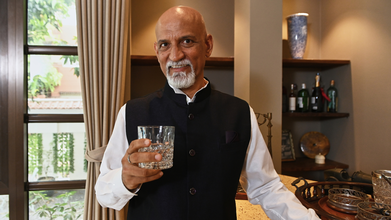- Health Conditions A-Z
- Health & Wellness
- Nutrition
- Fitness
- Health News
- Ayurveda
- Videos
- Medicine A-Z
- Parenting
- Web Stories
Why You're Not Losing Weight Despite Workout And Diets? 3 Sneaky Reasons Revealed

Why You’re Not Losing Weight (Credit: Canva)
You’ve been there – hitting the gym daily, swapping junk food for salads, and chugging water like a fitness guru. Yet, when you step on the scale, the needle barely moves, leaving you wondering what you’re doing wrong. If this sounds familiar, rest assured that you're not alone. Many people share this frustration, even after committing to a healthier lifestyle.
The truth is, weight loss isn't always as straightforward as the "calories in versus calories out" equation.
Like many others, I faced this same struggle. I remember feeling determined as I started my weight loss journey. I followed workout routines and diligently watched my diet, but week after week, the scale showed no significant change. I questioned my methods and began doubting whether my body was capable of shedding those extra pounds. Eventually, I realized that the issue wasn’t my effort but the hidden factors I hadn’t considered. What I learned from experts changed my approach – and my results.
What is Metabolic Adaptation?
Weight loss fundamentally revolves around creating a calorie deficit, meaning you burn more calories than you consume. But, as fitness expert Chloe Thomas points out, it’s not always that simple. According to Thomas, a personal trainer and nutrition coach, this deficit can trigger a phenomenon known as metabolic adaptation.
When your body is exposed to a reduced caloric intake over an extended period, it responds by slowing down your metabolism. “Your metabolism slows down in response to decreased caloric intake,” Thomas told the Mirror.
This adaptive process is a survival mechanism from our evolutionary past, where maintaining energy stores was crucial during periods of scarcity. Unfortunately, this same mechanism now makes weight loss more challenging for many of us.
To make matters more complicated, every individual has a “set point,” a weight range that the body naturally defends. This set point is determined by factors such as body composition, metabolic rate, and even genetics.
As Thomas explains, when you move too far from this set point, your body resists further weight loss by regulating hunger, energy expenditure, and fat storage.
Cardio vs. Strength Training
When trying to lose weight, many people automatically turn to cardio workouts, assuming that burning as many calories as possible during exercise is the key to success. However, focusing solely on cardio might not be the best strategy.
Fitness experts emphasize on the importance of strength training in any weight loss regimen. While cardio can help create a calorie deficit, most believing that lifting weights plays an even more critical role in long-term fat loss.
The reason? Muscle tissue requires more energy to maintain than fat tissue. By incorporating strength training into your routine, you build muscle mass, which in turn boosts your metabolism.
Cardio is a great extra tool to burn some extra calorie, but the most important part of any workout routine is lifting weights. Strength training may not torch as many calories as a cardio session, but it has a lasting impact on your body’s ability to burn fat.
Even weight loss coaches and many experts, advise against spending hours on cardio machines and instead encourages focusing on targeted muscle groups through weight lifting. When you strength train, you can focus on specific muscles that you can tone and create shape.
The benefits of strength training are backed by science too: research from Stanford University shows that people who engage in strength training lose more fat and better maintain their blood sugar than those who rely solely on cardio.
Why You’re Not Losing Weight: 3 Sneaky Culprits
Even with the right knowledge and effort, there are still obstacles that can stand in the way of weight loss. Here are some lesser-known factors that could be holding you back:
1. Sitting for Long Periods
You might be killing it in the gym, but if you’re sedentary for the rest of the day, it could hinder your progress. Studies show that sitting for long periods reduces the activity of lipoprotein lipase (LPL), an enzyme responsible for breaking down fat and converting it into energy.
An hour-long workout followed by hours at a desk can reduce your body’s ability to burn fat effectively. To combat this, make it a point to move around for at least a few minutes every hour, whether it’s stretching or taking a short walk.
2. Overly Restrictive Diets
Cutting calories too drastically can backfire, leading to nutrient deficiencies that slow your metabolism. When your body lacks essential nutrients, thyroid function decreases, which can halt your weight loss efforts. Instead of fixating on calorie count, focus on the quality of the food you’re eating.
A diet rich in nutrient-dense foods like lean proteins, healthy fats, and whole grains will keep your metabolism humming and your energy levels steady.
3. Genetics and Fat Storage
Believe it or not, your DNA could play a role in where your body tends to store fat. Some people are genetically predisposed to carry more fat in certain areas, such as the belly or thighs, which can make weight loss in these areas particularly stubborn.
While you can’t change your genes, adopting a balanced lifestyle that includes healthy eating, regular exercise, and stress management can help counteract some of the genetic influences on fat storage.
How to Tackle Stubborn Fat
If you’ve adjusted your diet, committed to strength training, and addressed the sneaky culprits mentioned above, but still find yourself battling stubborn fat, it may be time to consider alternative solutions only after consulting with an expert. All treatments work by targeting fat cells and enhancing muscle definition, helping you fine-tune your fitness results.
Weight loss is a complex journey influenced by numerous factors beyond just diet and exercise. From metabolic adaptation and set points to the balance between cardio and strength training, understanding how your body works can help you make informed decisions about your health. Remember, patience is key, and sometimes it’s necessary to tweak your approach to see lasting results. And if you find yourself stuck despite your best efforts, there are always additional tools available to help you achieve your goals.
Your 'Innocent Habits' Could Be Ruining Your Health: Heart Doctor Lists 5 Ways To Prevent Health Loss

(Credit-Canva)
We all have habits we know are bad for us, yet we don’t stop doing them. Most smokers know that smoking is bad for their health, and even say they would like to quit, but something stops them. The National Institute of Health (NIH) explains how 70% smokers say they would like to quit, people who abuse drugs and alcohol also wish to give up their addiction but find it extremely difficult.
As such, there are many habits, people think do not harm them, but can take a toll on their body. In a recently posted video, Cardiologist Dmitry Yaranov, listed 5 habits that are slowly chipping away at your health.
‘Innocent Habits’ That Are Hurting Your Health
In the video caption, Dr Yaranov explained that these habits, often picked up by mistake, can make your body weaker and more susceptible to illnesses.
Running on Empty Fuel
Telling yourself, "I'll sleep when I'm dead," is a shortcut right to that outcome. Chronic lack of rest isn't just tiring; it’s physically damaging. Skimping on sleep constantly raises your blood pressure, makes you gain weight, and guarantees a serious burnout that you won't be able to recover from easily. Prioritize rest now.
Sitting All Day, Scrolling All Night
From your office chair to the car and the couch, sitting for too many hours is silently wrecking your health. Being constantly still tightens your back, slows down your metabolism, hurts your digestion, and weakens your heart. Your body needs regular movement to survive, not just a ten-minute walk. Get up and move more often.
Brushing Off Stress
Saying "I'm fine" while carrying the weight of the world is a dangerous habit. Eventually, your body will stop listening to your mind. Stress you try to ignore explodes into physical problems, like unexplained chest tightness, constant gut issues, severe insomnia, and sudden panic attacks. Acknowledge your stress before it breaks you.
Eating Whatever's Fast
Skipping your morning meal, grabbing drive-thru lunch, and relying on sugar for quick energy creates chaos inside you. This erratic eating causes your blood sugar to swing wildly, stressing every major organ. Your body needs consistent, nutritious fuel, not a constant roller coaster of sugar and grease. Feed your body well, not fast.
Saying Yes When You Should’ve Said No
You are always available, doing favors and taking on tasks for everyone else. But when was the last time you put your own needs first? Overcommitting drains your energy, time, and mental resources until there’s nothing left. This chronic neglect leads to resentment and exhaustion. Guard your boundaries and put yourself on the list.
How Can You Kick Harmful Habits?
Kicking any kind of habit can be difficult. The NIH explains that habits are just routines that we do without thinking. They are a normal, often helpful part of life, but they can also be things that harm your health.
While some habits are useful and do not require a lot of thinking, like brushing, showering, driving, other habits are based off-of pleasure or dopamine hit like smoking. Both types of habit use the same mechanics, but pleasure-based habits are much harder to break because of a chemical called dopamine.
The good news is that humans are not completely controlled by habit. We have other brain areas that can help us make better choices for our long-term health. There is no single solution; what works depends on the person. Dr. Volkow emphasizes that it's "not one size fits all." However, scientists recommend a few helpful techniques:
Increase Awareness and Avoid Triggers
Figure out the exact time and place where your bad habit happens. Knowing your triggers is the first major step toward taking back control. Next, make a plan to avoid those spots. If the candy machine is your weakness, take a different route. Stay away from people who tempt you.
Mentally Practice the Good Behavior
Before you face a tempting situation, close your eyes and picture yourself succeeding. Imagine choosing water over a sugary drink. Mentally rehearsing the healthy choice can prepare your brain. This practice boosts your chances of making the right decision when the real moment arrives.
Replace the Bad Habit with a New One
Don't just stop the bad habit; actively replace that routine with a new, healthy activity. Fill the void with something constructive. Many people successfully replace strong urges, even addictions, with intense exercise like running. A new ritual helps fight the old habit's pull.
COVID And Flu Could Increase Your Risk Of Heart Attacks Or Stroke: American Heart Association Study

(Credit-Canva)
As COVID and viral infections cases rise in numbers, researchers are finding out how, following the bout of cases, the risk of heart diseases has also increased in people. To explore this connection, new research published today in the Journal of the American Heart Association reveals a strong link between both acute and chronic viral infections and an increased risk of serious cardiovascular events, such as heart attacks and strokes.
The lead author, Dr. Kosuke Kawai, noted that while we know viruses can cause cancer, their link to non-infectious diseases like heart disease hasn't been clear. This study confirms that acute (short-term) and chronic (long-term) viral infections are connected to both immediate and lasting risks for heart and brain events.
How Do Short Infections Cause Harm To Heart?
When your body fights off a virus, your immune system releases chemicals that cause inflammation (swelling) and make your blood more likely to clot. Both of these problems can linger even after the virus is gone.
This ongoing inflammation and tendency to clot can damage the heart and blood vessels, which is likely why the risk of a heart attack or stroke spikes so dramatically right after an illness.
The research details what happens to your heart risk right after you get a respiratory infection. The study combined data from many high-quality reports and found a major, temporary jump in risk:
Influenza (Flu)
In the month immediately following a confirmed flu infection, people were 4 times more likely to have a heart attack and 5 times more likely to have a stroke compared to when they weren't sick.
COVID-19
After a COVID infection, the risk was also high. People were 3 times more likely to have a heart attack and 3 times more likely to have a stroke in the first 14 weeks. Worryingly, this risk stayed higher than normal for an entire year.
What Infections Cause Long-Term Heart Risk?
This part of the study focused on people who have had certain chronic (long-lasting) viral infections, tracking their health for an average of over five years to see if their risk remained high:
HIV Infection
People with HIV had a 60% higher risk of heart attack and a 45% higher risk of stroke.
Hepatitis C
This infection was linked to a 27% higher risk of heart attack and a 23% higher risk of stroke.
Shingles (Herpes Zoster)
Even this common virus was associated with a 12% higher risk of heart attack and an 18% higher risk of stroke.
Even though these percentage increases are smaller than the immediate post-flu/COVID jump, they are still very important because the risk lasts for years. Shingles, for example, affects about one in three people in their lifetime, meaning that this seemingly small increase in risk will lead to a large number of extra heart problems across the general population over time.
How Can We Prevent Risk Of Heart Attacks After Infections?
The study suggests a powerful way to fight these risks is by getting vaccinated. The findings strongly support the idea that increasing the number of people who get flu, COVID, and shingles shots could lower the overall rate of heart attacks and strokes in the community. As an example, previous research has shown that getting a flu shot can be linked to a 34% lower risk of major heart problems.
The American Heart Association recommends that everyone, especially those with existing heart conditions or heart risk factors, talk to their doctor about getting the right vaccines. Vaccination is a simple step that offers crucial protection to people whose hearts are already vulnerable.
It’s important to remember that this study was based on looking at people's health records (observational studies), not on controlled experiments. The main focus was on single viruses. Researchers noted that we still need more studies to fully understand how some other viruses, like dengue and HPV, might be linked to heart disease.
Is India Drinking More Than The Rest Of The World? Recent Report Reveals

Credits: Canva
Is India getting drunk? While rest of the world is cutting its alcohol consumption, India's shows some contradicting results. As per a London-based market analytics firm Euromonitor International, the country is projected to consume an additional 357 million litres between 2024 and 2029. This is the biggest increase anywhere in the world.
the report titled World Market for Alcoholic Drinks 2025 notes that the there is a stagnating overall in alcohol consumption, and the only high points are countries like India, Brazil, Mexico, and South Africa.
Why Are Indians Drinking So Much?
The reason is Zebra Stripping. What exactly is that? Zebra Stripping is the act of switching between alcoholic and non-alcoholic drinks in the same social setting. The Print reported that people in India are moderating their alcohol consumption, rather than completely dismissing it. People, however, are avoiding binge drinking, and switching to zebra stripping.
Health is the main driving factor of this change. There is a generational divide among the Gen Z adults of legal drinking age. As 36% of them have never consumed alcohol. This is the case globally too. For instance, in the US, the National Institute of Drug Abuse shows that lifetime drinking, past month drinking, and past year drinking among young people have declined from year 2000. This means that the decline is most severely seen among the Gen Z, those who are born between 1997 to 2012.
Despite this drop in Gen Z drinkers, the report, aforementioned, shows the number of alcohol consumers will only increase.
How Can Alcohol Affect Your Body?
The National Institute on Alcohol Abuse and Alcoholism notes that alcohol could lead to organ damage and immune dysregulation. Alcohol could cause cardiac arrhythmias, cardiomyopathy, ischemic heart disease, hypertension, ischemic stroke or hemorrhagic stroke, acute respiratory disease, distress syndrome, pneumonia, oesophageal cancer, and oral cavity cancer.
Other impact that alcohol could cause on one's body are:
- Steatosis or fatty liver
- Steatohepatitis
- Fibrosis
- Cirrhosis
- Alcohol-associated hepatitis
- Liver Cancer
- Myopathy
- Muscle wastage
- Acute pancreatitis
- Chronic pancreatitis
- Gut leakiness
- Microbial dysbiosis
- Colorectal cancer
- Impaired fracture repair
- Reduce bone density
It can also increase the risk of liver, colon, breast, oral cavity and rectum cancer.
The Centers for Disease Control and Prevention (CDC), USA, notes that around 178,000 deaths have happened in the US, annually, just by excessive alcohol use. CDC notes that while drinking levels at any point is not safe, moderate alcohol use is only up to two drinks or less in a day for men, and one drink or less in a day for women.
Apart from the diseases and chronic conditions, CDC notes that alcohol use could also lead to injuries through motor vehicle crashes, falls, drownings, and burns. It could also lead to violence, overdose, alcohol poisoning, sexual transmitted infections, miscarriage, stillbirth, or fetal alcohol spectrum disorder (FASD).
© 2024 Bennett, Coleman & Company Limited

